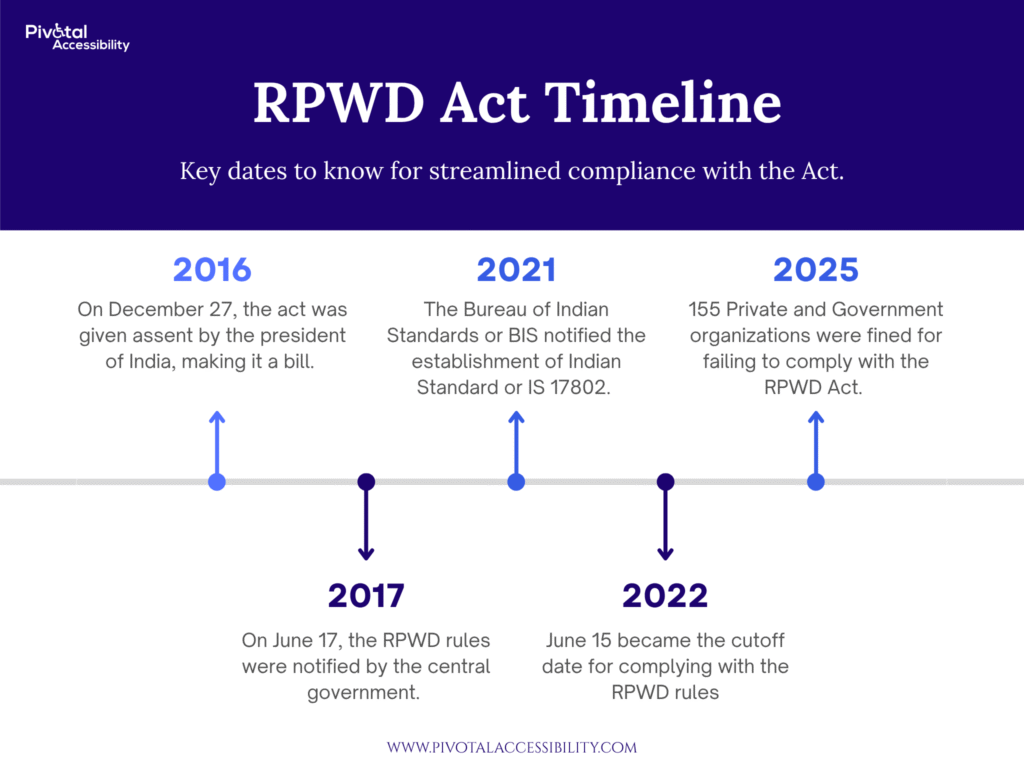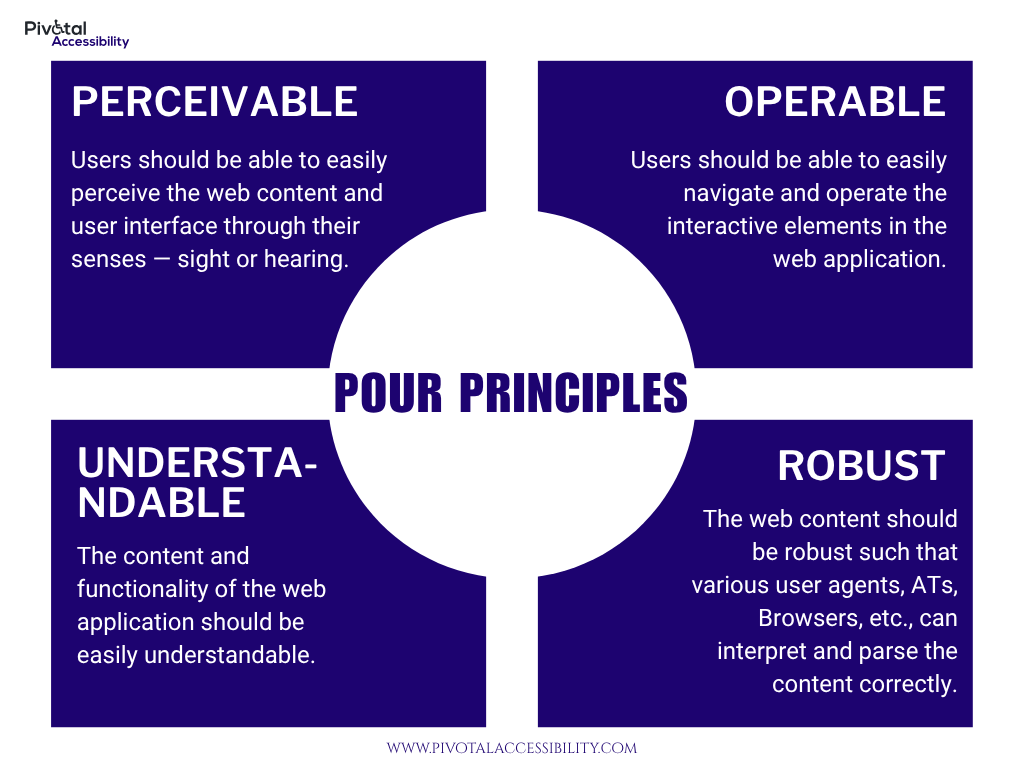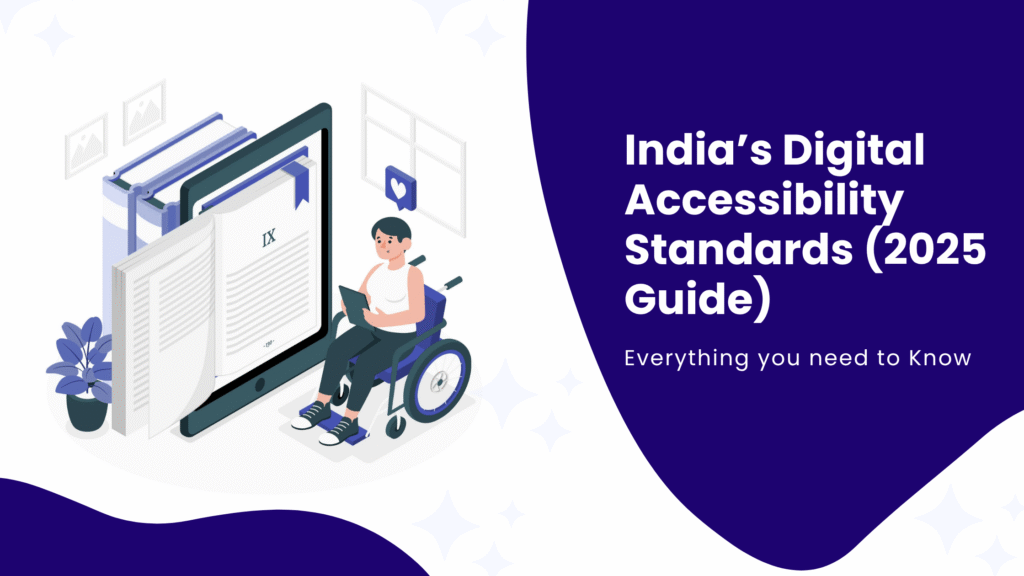The Rights of Persons with Disabilities (RPWD) Act, 2016, is India’s landmark legislation aimed at safeguarding the rights and dignity of persons with disabilities. It replaces the earlier Persons with Disabilities (PWD) Act, 1995, expanding the recognized categories of disability from 7 to 21 conditions, including autism, thalassemia, and multiple sclerosis. This modernized framework reflects India’s commitment to the UN Convention on the Rights of Persons with Disabilities (UNCRPD) and focuses on making education, employment, infrastructure, and digital platforms inclusive and accessible.
Though enacted in December 2016, the RPWD Act came into effect in April 2017, setting the legal foundation for ensuring equal participation and barrier-free access across all walks of life, physical, informational, and digital.
Key Accessibility Provisions under the RPWD Act (Sections 40–46)
Out of the 102 sections in the Act, Sections 40 to 46 directly address accessibility requirements across infrastructure, transportation, and digital services. These sections are legally binding for both public and private organizations operating in India.
Section 40 – Framing Accessibility Standards
This section empowers the Central Government, in consultation with the Chief Commissioner for Persons with Disabilities, to formulate mandatory accessibility standards. It includes, but is not limited to:
- Information and Communication Technology (ICT) accessibility
- Built environment standards
- Guidelines for consumer products and services
Section 40 forms the basis for digital accessibility standards such as IS 17802, India’s formal framework for accessible ICT.
Section 42 – Accessible Content for All
Section 42 makes it compulsory for the government and content providers to ensure accessible information and media, including:
- All audio, print, and electronic content must be provided in accessible formats.
- Electronic media must support captions, audio descriptions, and Indian Sign Language (ISL) for persons with visual, auditory, or cognitive disabilities.
- Frequently used digital products and services (websites, apps, platforms) must be made universally accessible.
Section 46 – Compliance Timeline for Accessibility
Section 46 lays out a strict two-year compliance window from the date of enactment (i.e., April 2017) for all service providers, government and private, to align their offerings with the accessibility norms established under the Act. Failure to comply may result in legal and financial penalties under subsequent rules and enforcement mechanisms.
Together, these provisions emphasize that digital accessibility is not optional but a legal obligation in India, reinforced by updated standards such as IS 17802 and the 2024 RPWD Amendment.
Timeline of Accessibility Law in India

India’s digital accessibility landscape has evolved steadily through key milestones in legislation, rule-making, and enforcement. Here’s a chronological overview of the RPWD Act implementation and major developments:
- December 14, 2016: The Rights of Persons with Disabilities (RPWD) Act, 2016 was enacted by the Parliament of India, marking a major shift in disability rights legislation.
- December 16, 2016: The Act was passed by the Rajya Sabha, completing its journey through both houses of Parliament.
- December 27, 2016: The Act received Presidential assent, officially becoming law.
- April 19, 2017: The RPWD Act came into force, legally binding all relevant stakeholders to initiate accessibility reforms.
- June 15, 2017: The RPWD Rules, 2017, were formally notified by the Central Government, providing operational details and timelines for enforcement.
- December 24, 2021: The Bureau of Indian Standards (BIS) introduced the IS 17802 digital accessibility standards, aligning India’s ICT accessibility guidelines with global best practices.
- June 15, 2022: This was the official deadline for all public and private service providers to comply with the accessibility standards under the RPWD Act.
- June 19, 2024: The RPWD Act was amended, introducing significant updates including a new clause in Rule 15 focusing on accessible education infrastructure for children with disabilities.
- February 2025: In a landmark enforcement action, 155 private and government organizations were penalized for non-compliance with the digital accessibility mandates of the RPWD Act.
This timeline highlights the growing importance of digital inclusion and compliance in India. Staying up to date with these milestones is crucial for organizations seeking to avoid penalties and create inclusive user experiences.
IS 17802: India’s Digital Accessibility Standard for ICT
IS 17802 is India’s official standard for ensuring digital accessibility in Information and Communication Technology (ICT) products and services. Published by the Bureau of Indian Standards (BIS) in December 2021, it was later incorporated into the RPWD Rules via the 2023 amendment and is now legally enforceable under Indian law.
Designed to make the digital ecosystem inclusive for persons with disabilities, IS 17802 also enhances usability for all users. It is aligned with internationally recognized frameworks such as the Web Content Accessibility Guidelines (WCAG), but also takes into account India’s unique linguistic and cultural diversity, such as support for regional languages.
Structure of IS 17802
The standard is divided into two core parts:
Requirements
This section lays out the core accessibility requirements grounded in the four foundational principles of digital accessibility:
Perceivable, Operable, Understandable, and Robust (POUR). Key requirements include:
- Providing text alternatives (alt text) for non-text content
- Enabling full keyboard navigation for users unable to use a mouse
- Ensuring sufficient color contrast for readability
- Maintaining a logical focus order for seamless interaction
- Guaranteeing compatibility with assistive technologies (e.g., screen readers)
Determination of Conformance
This section explains how organizations can assess and document their compliance with IS 17802. It outlines steps businesses should take to meet the standards, including:
- Creating a compliance roadmap with clear timelines
- Investing in testing tools and trained accessibility testers
- Gathering feedback from users with disabilities
- Consulting with digital accessibility experts for best practices
Adhering to IS 17802 is not just a legal obligation; it is a critical step toward building a more inclusive digital India. Read our detailed blog on IS 17802 standards to learn more about it.
The Four Principles of Accessibility and How They Relate to the RPWD Act

At the heart of both the IS 17802 standard and the globally recognized Web Content Accessibility Guidelines (WCAG) are four foundational principles that define what it means for a digital product to be truly accessible. These are:
- Perceivable: Information and user interface components must be presented in ways that users can perceive, whether through sight, hearing, or touch. This includes providing text alternatives for images and ensuring content is distinguishable by screen readers.
- Operable: Users must be able to operate interface components and navigate content regardless of their abilities. This includes keyboard navigation, giving users time to read and respond, and avoiding content that could cause seizures.
- Understandable: Both the information and the operation of the user interface must be clear and predictable. This includes readable language, consistent navigation, and error messages that help users recover from mistakes.
- Robust: Content must be robust enough to be interpreted reliably by a wide range of user agents, including assistive technologies.
These principles form the backbone of IS 17802 and serve as the benchmark for evaluating whether a website, mobile app, or digital tool is compliant with Indian and international accessibility standards. In the context of the RPWD Act and its amendments, especially the 2024 focus on education and ICT accessibility, these principles help organizations and developers understand how to build inclusive experiences from the ground up by creating a sustainable accessibility strategy.
Whether you’re designing an educational platform, a government portal, or a private sector app, aligning with these four principles is the first step in ensuring that your digital environment is accessible to everyone, regardless of ability.
Amendment to the RPWD Act in 2024
In June 2024, the Rights of Persons with Disabilities (RPWD) Act was amended, specifically updating Sub-rule 1 of Rule 15, which was originally enforced in 2017. While the original Rule 15 focused on ensuring accessibility in physical environments, transportation systems, and information and communication, the 2024 amendment marked a significant shift by expanding its scope to include educational institutions.
This new clause mandates institutions to identify barriers that prevent children with disabilities from fully participating in educational settings. More importantly, it encourages the development and implementation of cost-effective, sustainable solutions that can be adopted by both public and private educational institutions across India. This move is particularly impactful in ensuring that inclusive education is not just a theoretical ideal but a legal obligation that institutions must act upon.
By formally including education within the ambit of accessibility rules, the amendment reinforces the Government of India’s commitment to the UNCRPD (United Nations Convention on the Rights of Persons with Disabilities) and aligns national laws with global standards.
How to Deal with Digital Accessibility in India Today
India’s digital landscape has seen significant developments in accessibility awareness and enforcement over the past few years. With the formal inclusion of IS 17802 in the RPWD framework and increased government scrutiny, digital accessibility compliance is no longer optional; it’s mandatory.
A notable turning point came in February 2025, when 155 private and government organizations, including several central ministries, were fined for failing to meet digital accessibility standards under the RPWD Act. This development not only signaled the enforcement of legal mandates but also emphasized the need for all digital platforms, government or private, to be inclusive and accessible to people with disabilities.
The rising awareness of digital accessibility laws in India is a positive sign. However, compliance can often be complex, involving detailed audits, remediation, and ongoing monitoring. That’s where Pivotal Accessibility comes in. As a trusted accessibility solutions provider, we specialize in helping organizations understand and implement accessibility standards aligned with the RPWD Act, IS 17802, and WCAG guidelines.
If you’re unsure where to start or how compliant your website, mobile app, or digital service is, we can help. Leave a query on our website or fill out the contact us form, and our team will get in touch to guide you through your journey toward becoming fully accessible and legally compliant.

